Six years after Queen
Victoria began her long reign as England’s monarch, train travel
began its long slow climb to become the chief mode of transportation
not only in England but in America.
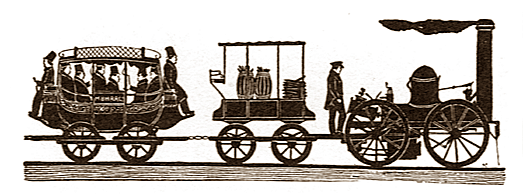
In fact, the first railroad train, the “DeWitt Clinton,” pulled out
for its first run along 17 miles of track from Albany to
Schenectady, New York. Everyone marveled at the new invention. But
no one sitting in the stagecoach-like rail cars even dreamed that
they could some day cross this great land.
Up until that time, most people traveled by stagecoach and
steamboat. The former offered a bumpy, dusty ride while the latter
enabled passengers to travel somewhat luxuriously along our
country’s great rivers.
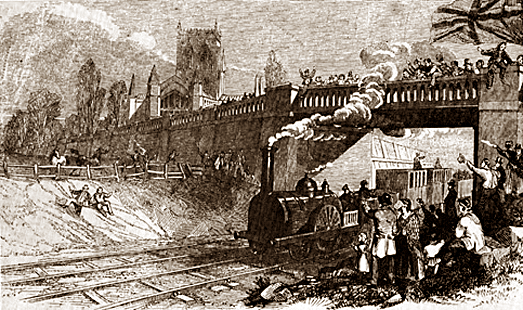
From the start, the
American railroads had to make riding their trains more comfortable
to compete with the steamboats. Early trains carried passengers for
relatively short distances, so sleeping arrangements weren’t
necessary. But as the distances became longer, a means of providing
a place to sleep on board became a prime concern since trains didn’t
travel all that fast.
The Cumberland Valley Railroad of Pennsylvania, running between
Harrisburg and Chambersburg—a distance of 54 miles—first attempted
to furnish passengers with an onboard place to sleep. During the
winter, east-bound passengers arrived exhausted at Chambersburg late
at night by stagecoach, after a fatiguing trip over the mountains.
Since many wished to continue their journey to Harrisburg so they
could catch the morning train for Philadelphia, it became imperative
to furnish onboard sleeping accommodations. The railroad’s owners
divided a passenger car into four sections using transverse
partitions. Each section contained three berths– lower, middle, and
upper. The car ran from the winter of 1836-37 to 1848 when they
abandoned it.
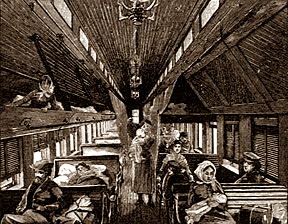 In
1858, George M. Pullman made a trip to Chicago, Illinois, from
Buffalo, New York, aboard the Lake Shore Railroad. A new sleeping
car, attached to this train, was making its first trip. Pullman
stepped in to take a look at it and decided to spend the night in
one of its berths. After being continuously tossed about, he sought
refuge on a seat in the end of the car. He thought about his
experience and figured that in a country of great distances like the
United States, railroads should offer passengers cars easily
convertible into comfortable and convenient day or night coaches,
supplied with appointments similar to those aboard steamboats.
In
1858, George M. Pullman made a trip to Chicago, Illinois, from
Buffalo, New York, aboard the Lake Shore Railroad. A new sleeping
car, attached to this train, was making its first trip. Pullman
stepped in to take a look at it and decided to spend the night in
one of its berths. After being continuously tossed about, he sought
refuge on a seat in the end of the car. He thought about his
experience and figured that in a country of great distances like the
United States, railroads should offer passengers cars easily
convertible into comfortable and convenient day or night coaches,
supplied with appointments similar to those aboard steamboats.
In 1864, Pullman perfected his plans for a car which he offered a
marked and radical improvement from previous sleeping cars. He named
it the " Pioneer." This car had improved trucks and a raised deck,
and Pullman built it a foot wider and two and a half feet higher
than any car then in service. In order to introduce a hinged upper
berth, which, when fastened up, formed a recess behind it for
stowing the necessary bedding in daytime. Before that the mattresses
had been piled in one end of the car and had to be dragged through
the aisle when needed. Pullman realized the dimensions of the
railroad bridges and station platforms wouldn’t allow the car to
pass over the line, but he believed that an attractive car,
constructed upon correct principles, would find its way into service
against all obstacles.
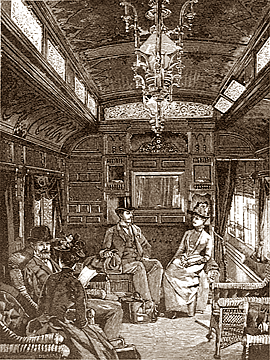 With
the tremendous success of the sleeping car, railroads next
introduced parlor or drawing-room cars for day runs, which added
greatly to the luxury of travel, enabling passengers to secure seats
in advance, and enjoy many comforts which weren’t found in ordinary
cars. Eventually, these became known as “palace” cars and railroads
included them as an essential part of their equipment. The Wagner
Car Company of New York was one of the first to furnish them.
With
the tremendous success of the sleeping car, railroads next
introduced parlor or drawing-room cars for day runs, which added
greatly to the luxury of travel, enabling passengers to secure seats
in advance, and enjoy many comforts which weren’t found in ordinary
cars. Eventually, these became known as “palace” cars and railroads
included them as an essential part of their equipment. The Wagner
Car Company of New York was one of the first to furnish them.
After introducing sleeping and luxurious parlor cars, the railroads
turned to fulfilling the demand for serving meals on their trains.
Why should a train stop at a station for meals any more than a
steamboat should tie up to a wharf for the same purpose? So the
Pullman Car Company introduced the hotel car—essentially a sleeping
car with a kitchen and pantries in one end and portable tables which
could be placed between the seats of each section and upon which
meals could be conveniently served. Pullman named his first hotel
car the “President,” and put it into service on the Great Western
Railway of Canada in 1867.
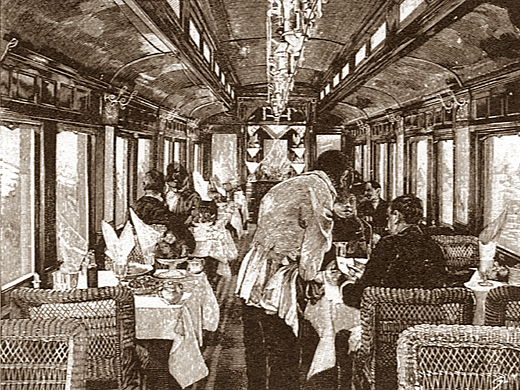
But that still wasn’t
enough to supply the wants of the growing number of railway
passengers. So the dining car came next. A complete restaurant, with
a large kitchen and pantries at one end and the main body of the car
fitted up as a dining room, it offered a place in which all the
passengers in the train could take their meals comfortably. Pullman
named his first dining car the “Delmonico,” which began service in
1868 on the Chicago & Alton Railroad.
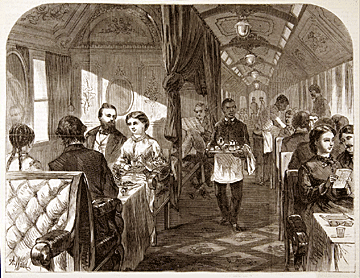 With
over 30,000 miles of track laid after the Civil War, the comforts
and conveniences of travel by rail on the main lines seemed to have
reached their peak. The heavy “T” rails had replaced the various
forms previously used. Their improved fastenings, the reductions in
curvature, and the greater care exercised in laying them had made
travel extremely smooth, while the improvements in rolling stock had
reduced the jerking, jolting, and oscillation of the cars. The road
beds had also been properly ditched, drained, and ballasted with
broken stone or gravel, the dust overcome, the sparks arrested, so
cleanliness had at last been made possible on a railway train.
With
over 30,000 miles of track laid after the Civil War, the comforts
and conveniences of travel by rail on the main lines seemed to have
reached their peak. The heavy “T” rails had replaced the various
forms previously used. Their improved fastenings, the reductions in
curvature, and the greater care exercised in laying them had made
travel extremely smooth, while the improvements in rolling stock had
reduced the jerking, jolting, and oscillation of the cars. The road
beds had also been properly ditched, drained, and ballasted with
broken stone or gravel, the dust overcome, the sparks arrested, so
cleanliness had at last been made possible on a railway train.
And that left one major problem to the be solved—heating the cars.
The solution was the invention of a method for circulating hot water
from the boiler of the locomotive through pipes running near the
floor of the cars. Not only did passengers now have warm feet, but
the loss of life from train fires originating from stoves had been
halted. However, heating a detached car was still a problem until
the discovery of electricity.
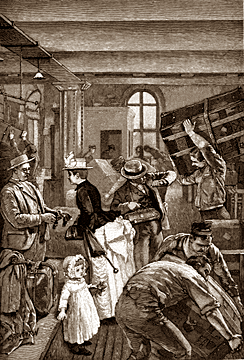 Baggage,
on the other hand, presented a problem from the beginning.
Originally, railways allowed passengers to pick out their baggage at
their destination, resulting in a lack of accountability which led
to much confusion, frequent losses, and heavy claims against the
railroads. The solution lay in the introduction of a system known as
“checking.” A clerk attached a metal disk, bearing a number and the
destination of the bag, to each article and gave a duplicate to the
owner, which acted as a receipt. Passengers then presented these
receipts to clerks at their destinations to claim their bags.
Baggage,
on the other hand, presented a problem from the beginning.
Originally, railways allowed passengers to pick out their baggage at
their destination, resulting in a lack of accountability which led
to much confusion, frequent losses, and heavy claims against the
railroads. The solution lay in the introduction of a system known as
“checking.” A clerk attached a metal disk, bearing a number and the
destination of the bag, to each article and gave a duplicate to the
owner, which acted as a receipt. Passengers then presented these
receipts to clerks at their destinations to claim their bags.
Railways soon united in arranging for through checks which when
attached to baggage would insure its being sent safely to distant
points over lines composed of many connecting rail lines. The check
system led to the introduction of another marked convenience in the
handling of baggage–the baggage express or transfer company. One of
its agents checked trunks at the passenger's home and hauled them to
the train. Another agent would take up the checks aboard the train
as it neared its destination and have the trunks delivered to the
correct address at the passenger’s destination.
Coupon tickets covering trips over several different railways saved
passengers from purchasing separate tickets from several railroads
over which they had to pass. Their introduction necessitated an
agreement among the principal railroads and the adoption of an
extensive system of accountability for the purpose of making
settlements of the amounts represented by the coupons.
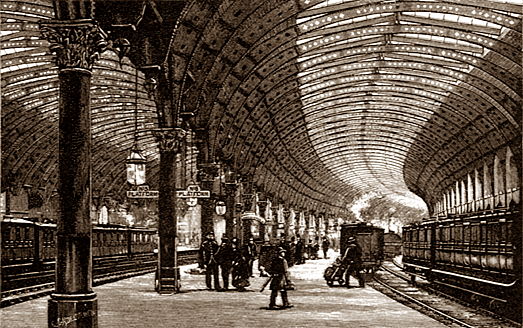
With the tremendous growth of the railroads and the vast number of
different rail lines, passengers often found themselves confused.
This forced the railroads to find ways to provide passengers with
the information they needed to start and continue their journeys.
Clocks stood in the stations with their hands set to the hour at
which the next train was to depart. Sign boards displayed the
stations at which departing trains would stop using horizontal
slats. And railroad employees called out necessary information and
directed passengers to the proper entrances, exits, and trains.
Larger passenger stations included a “Bureau of Information,” in
which a railroad employee answers questions about rail routes.
